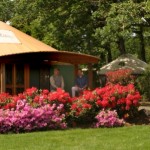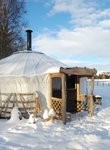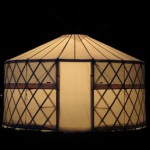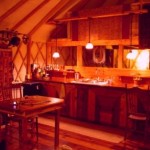
OUR FIRST GUEST BLOG!
When I was working on my book (YURTS:Living in the Round), I found Pete Dolan to be one of the most consistently knowledgeable—and helpful—people in the industry. Pete’s work in Customer Service at Pacific Yurts is one of the reasons their company maintains a legendary reputation for customer satisfaction.
I asked Pete to add his perspective as a guest blogger on the theme of “Buying a Yurt”. Here are his thoughts on
How to Work with a Yurt Company
First, check out company claims
I know these days everybody wants to do all of their research and comparisons online, but keep in mind how easy it is to put together a web site with today’s computers. Someone can put together a web site and make lots of claims without being able to backup or fulfill most of those claims.
It’s important to investigate companies to make sure they are reputable. One way you can do this is by checking with their local Better Business Bureau (www.bbb.org) to see if they have a satisfactory rating. It is worth checking to see if the company has changed their name, too, since this seems to be fairly common and there can be poor ratings for the company under previous names.
Also check web blogs to see if you can find people who have purchased from the companies you are considering in order to find out how satisfied they have been with the quality and service. Checking the company’s rating with Dunn & Bradstreet (www.dnb.com) can also give you a good indication if the company is likely to be around to help you in the future.
If someone’s price seems too good to be true, it probably is. Check the specifications. I’ve seen a number of companies make claims about their products being equal to or better than ours, but their prices were significantly lower. A closer check revealed that inexpensive hardware and fabrics were utilized and the wood frame included far fewer components. For example, one company had up to 32% fewer rafters and lattice in their yurt than our yurt of the same diameter. This can equate to significantly less strength as well.
What’s the biggest mistake people make in buying a yurt? The wrong size? No. You can always add a second yurt if the first turns out to be too small. The wrong style? Not usually. Most of the fabric yurts, for example, are pretty similar to each other, and if you’re buying new you usually get to choose your options and customize it to meet your personal needs.
Last winter I heard from someone who purchased a Mongolian import for a rainforest climate–she’s not having much success since that style of yurt wasn’t designed for her climate. But this is relatively uncommon.
Frankly, yurts aren’t that complicated and there aren’t too many mistakes people make, except perhaps overbuying (snow and wind kits where they aren’t necessary) or underbuying (not getting insulation where it would make a big difference). But none of these mistakes is terribly serious.
The most common mistake I see, and the only one that can be truly devastating, is buying from the wrong company. Devastating in the sense of losing your investment (worst case scenario) or dealing with months of headaches in trying to get your yurt set up and perhaps never getting all the right parts.
Most yurt companies are reputable businesses with a solid product. By far the majority take intense pride in their customer service and your satisfaction. My observation is that even the newest companies (in the middle of their learning curve) will usually bend over backwards to make sure that you are happy with their product and service. Let’s face it–It’s a feel good business and that’s why most people are into it.
However, every once in awhile a company just doesn’t seem able to perform. Yurts won’t arrive when they are supposed to. You’ll have your platform built but then the yurt doesn’t show up for three months–or sometimes it’s 6 months. Meanwhile your platform is sitting there exposed to weather and the elements. The baby that was supposed to be born three months after the yurt arrives is born in a makeshift RV (yes, that’s a true story) three months before the yurt ever shows up.
Yurts in Paris!
In 2003, inspired and organized by renowned French photographer Yann Arthus-Bertand, six directors set off across the world to “interview the inhabitants of the planet” on life’s essential questions. Six thousand interviews later they had visited over 65 countries and filmed over 4500 hours of footage.
 This month 450 hours of translated interviews will be shared with the world through an exhibit titled “6 Billion Others” at the Grand Palais in Paris. The showing takes place in twenty-five yurts set up as individual theaters. Each yurt theater is dedicated to one of 25 fundamental life questions ranging from money to family, love and happiness. Visitors (including over 140 school classes) will wander from yurt to yurt listening to the subtitled interviews and pondering their own relationship to life’s questions.
This month 450 hours of translated interviews will be shared with the world through an exhibit titled “6 Billion Others” at the Grand Palais in Paris. The showing takes place in twenty-five yurts set up as individual theaters. Each yurt theater is dedicated to one of 25 fundamental life questions ranging from money to family, love and happiness. Visitors (including over 140 school classes) will wander from yurt to yurt listening to the subtitled interviews and pondering their own relationship to life’s questions.
Colorado Yurt Company created the yurts in a rainbow of colors and says they are “thrilled and honored” to participate. “Our contemporary re-engineering of the traditional yurt appealed to the artist and designers in Paris,” said owner Emma Kiger. “The yurt structure is simple and elegant, plus it has the allure of a traditional, nomadic dwelling.”
Setting up 25 yurts in Paris Want to see 25 yurts go up in three minutes? Check out this YouTube video! You can also learn more about this amazing project and event at the “6 Billion Others” (6 milliards d’autres) website.
 The show runs from January 11 through February 12. After it closes in Paris there are plans to take the show to other locations, including San Francisco. Keep an eye out–those yurts just might show up in your city!
The show runs from January 11 through February 12. After it closes in Paris there are plans to take the show to other locations, including San Francisco. Keep an eye out–those yurts just might show up in your city!
Many congratulations to Colorado Yurt Company for your participation in this great event!
May 2009 be a great year for everyone in the yurt family…
becky
Holiday Yurt Greetings
In lieu of a Christmas Card, I’d like to forward this enchanting winter photo of a Scottish yurt, sent my way by Paul Spencer of Highland Yurts in Aberdeenshire, Scotland (Paul can be seen at right peeling a log with a draw knife). Paul tells me he will be offering some yurt making workshops this coming year (check the yurtinfo.org Calendar for a posting of workshop dates) and that he’s working on providing yurt camping in the Scottish Highlands.
One of the delights of this season is hearing from yurt builders in all parts of the world–from Europe to China and New Zealand. It’s amazing how broad this yurt phenomenon is. Each place on the planet modifies the design to fit their local climate and lifestyle needs, but all share in that marvelous roundness and sense of uplift.
I hope you are staying cozy in your yurt (or cool in the Southern Hemisphere). May you enjoy a special Solstice, a Merry Christmas and a joyous Holiday Season.
Yurts,
becky
Modern Green Yurt wins Design Award
Congratulations to yurt builder and designer extraordinaire Howie Oakes of Go Yurt Shelters for being First Place Winner of a Portland Spaces Design Award for his Modern Green Yurt.
The Awards article has this to say about the thirteen foot yurt:
Inspired by innovations in sailboat design, Oakes has used breathable
canvas; curved, linseed-oiled birch; and stainless steel hardware to
build a functional and elegant hideaway. The structure can be assembled
by one person in an hour, and the heaviest component weighs a mere 30
pounds.
A true family business, you can read the Go Yurt story here , but don’t try to reach Howie over the Christmas holidays. He’ll be camping with his family on the beaches of Baja–in a yurt, of course.
Tip of the week–don’t forget to pick up an extra hot water bottle at your local drugstore to keep your feet warm this winter! Throw it in your bed 30 minutes before you get in and your bed will be toasty warm.
Home is where the yurt is,
becky
And now…a word about Our Sponsors
Yes folks, I was able to spend this past year traveling the country talking with all of YOU about yurts because I have SPONSORS. These are visionary companies who agreed that it was in everyone’s best interests for me to pursue spreading the news and answering your questions about this affordable, accessible, aesthetic and amazing shelter we call the Yurt.
I went to these companies for sponsorships after my book came out because I knew them and respected their products and business practices. (I’ve owned yurts from two of the companies.) And now I’d like to express my heartfelt gratitude to my tour sponsors (drum roll, please): Colorado Yurt Company, Rainier Yurts and Pacific Yurts. Without them it wouldn’t have been remotely possible to do what I did this past year!
All three companies have also participated as sponsors for my yurtinfo.org website, along with GoYurt Shelters. This has enabled me to completely update and redesign the website, making it easier to navigate and adding information that is useful to everyone. For example, I’ve added a couple of excerpts from my book on "How to Buy a Yurt" and "Building Codes", plus new pages on Yurt Workshops, Yurt Financing and Yurt Consulting. Coming soon, to a laptop near you…(hopefully by March at the latest)!
Todd and Monica have a 30′ fabric yurt, but unfortunately they purchased it a couple of years ago from a company that advertises cheap yurts. There were so many problems with their yurt when it arrived (six months late) that it took them an additional six months to put it up. The good side, they said, is that they now know enough about yurts to build their own.
The most amazing thing about Todd and Monica’s yurt is the insulation. In addition to a layer of the usual Reflectix bubble wrap/foil insulation, Monica added a complete inside layer of real felt. The felt, imported from India, came in 7′ rolls. Monica hand stitched the wall sections, with cutouts for the windows, and had a friend machine-stitch 6 large pie-shaped wedges to go on top of the rafters.
The Reflectix layer, which is sandwiched between the felt and the outer covering of the yurt, functions as a
vapor barrier as well as providing additional insulation (and reflecting out the sun’s heat in the summer). Monica pointed out the importance of keeping the felt dry, as it can easily mold or rot if it gets wet.






